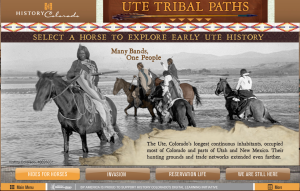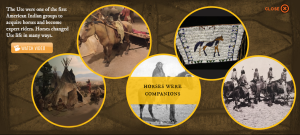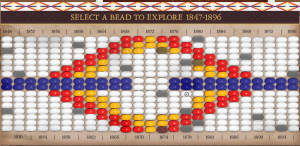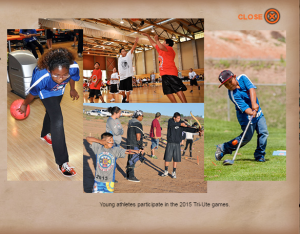Story
Ute Tribal Paths
A History Colorado Online Exhibit and Digital Badge
History Colorado is very excited to share “Ute Tribal Paths”, a free online exhibit and digital badge on Ute Indian history, traditions and contemporary lives.
Click here to access the Online Exhibit→
Click on the link to learn the story of Colorado’s longest continuous residents and explore:
- Maps of the traditional Ute territories and today’s three Ute reservations
- Video of Ute elder Alden Naranjo telling the story of the Bear Dance
- Biographies of Ute leaders, including Ignacio, Buckskin Charlie and Ouray.
- Photos of modern life on the three Ute reservations in Colorado in Utah.
- Images of Ute clothing and artwork that will be featured in the new Ute Indian Museum exhibits
In order to earn a digital badge, you’ll need to put historic events in the right places on a timeline and match traditional Ute activities to the season of the year.
About the online exhibits and digital badges:
In 2014, History Colorado received funding to create online exhibits and digital badges from the Institute of Museum and Library Sciences for K12 students and teachers. Our online exhibits bring history to life through immersive environments rich in historic photos, videos, primary sources and interactive elements like packing a digital suitcase. After students explore the online exhibits, they can earn an easy, medium or hard digital badge by completing activities like answering questions, completing timelines, and drawing conclusions from primary sources.
We chose five of the most compelling and relevant stories in Colorado history including Japanese Internment during WWII, African American history in Colorado, the Fur Trade, and Ute history. The final online exhibit is called La Gente: Colorado’s Hispano History.
Behind-the-scenes
Step 1 – Ask Teachers: History Colorado surveyed Colorado educators to find out what they needed. Their responses showed that they had limited resources to teach about Ute people, and they were eager for in-depth, engaging resources.
Step 2 – Pull together existing resources: The digital exhibit team decided to start with “Tribal Paths”, and exhibit that was hosted at the Colorado History Museum in 2008. We took the outline of that exhibit, and then began looking through History Colorado’s collections to decide which of artifacts and historic photographs could best tell the stories of the Utes. In 2013, Rocky Mountain PBS and History Colorado produced the “The Original Coloradans”, a special about the Utes. Many of the interviews from this special are included in the online exhibit.
Step 3 – Create the website: During this stage, we had lots of meetings and back and forth with our website developer. There were lots of fun challenges, like “how can you make a webpage that opens like a parfleche (a large folded “envelope” made out of deer hide)” or “how can we make a timeline show up on a piece of beadwork.”
Step 4 – Consultation with the tribes: Most important of all, representatives of the three Ute tribes reviewed all of the content and provided constructive feedback on the stories and presentation.
Step 5 – Test with Students: outreach educators have shared the online exhibit and digital badges with three 3rd and 4th grade classes at rural school, and the three 7th and 11th classes at a Denver metro school. The students all loved the online exhibits and were especially struck by the history of the removal of Ute Indians from Colorado. Students kept saying, “Hey, that’s not fair,” and “They lived here first, how can the government just take their land?!” We’re pleased that students are having a very personal interest and connection with Colorado history.




